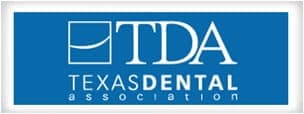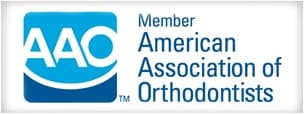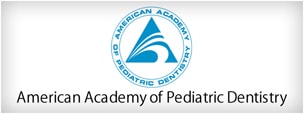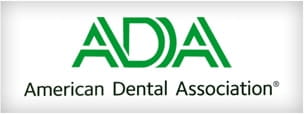Faq - Jim Bowden D.D.S
What Is The Difference Between A General Dentist And A Pediatric Dentist?
A pediatric dentist is different from a general or "family" dentist. After becoming a general dentist, the pediatric dentist then completes an extra two-year training program to specialize in the area of pediatric dentistry. The pediatric dentist is specifically trained to manage the child in the dental setting. The pediatric dental office is geared specifically to provide a low anxiety-producing environment that is non-threatening to the child. The environment is crucial to help mold a child’s experience in the dental office. A positive dental experience as a child will lead to lessened anxiety regarding dental visits as an adult and one who is more apt to understand the importance of the regular dental care.
The answers to the following questions are based on what a pediatric specialist recommends for the child regarding dental health. The answers are also based on what to expect if taking your child to the pediatric dentist. If you choose to take your child to a general practicing dentist, the methods and recommendations will vary.
When Is The Recommended Age For The Child’s First Dental Visit?
The American Academy of Pediatric Dentistry recommends the child's first dental visit occur shortly after the child's first birthday. If you choose to take your child to a general dentist, they usually do not want to see the child until they are 4-5 years of age. However, for a number of reasons, the earlier the child visits the dentist, the better. First, the earlier the child is introduced to the pediatric dental environment, the less anxiety they will have regarding the dental visit. Second, the earlier dental decay is diagnosed, the earlier it can be controlled. Third, the parent is able to understand questions regarding eruption schedules, brushing recommendations, fluoride questions, pacifier recommendations, bottle or breast feeding questions and any other questions regarding the child’s dental health. As all of these factors are important in the future dental health of the child, the one factor that is probably the most important is that of the lessened anxiety in the dental environment. Those children who start at the dentist at an early age are less anxious when it comes to the dental visit, especially if any treatment is indicated. Children who are seen for the first time at 4 and 5 years of age tend to be more anxious regarding the visit. Consequently, the child being seen at 4 or 5 years of age for the first time has a greater likelihood of having dental decay that will require treatment. These children tend to be more anxious about dental treatment than those who have seen the dentist for two to three years before requiring any treatment.
How Often Should My Child See The Pediatric Dentist?
Due to growth and development, children are constantly changing. Children experience many dental changes during this period. The American Academy of Pediatric Dentistry recommends the child visit the pediatric dentist every six months. This not only develops good dental health care habits in the child, it also is important in order to monitor the rapid dental changes occurring in the child. Dental decay progresses very rapidly in the child. Six month dental check-ups lead to earlier detection of many dental cavities, thus preventing them from becoming much more extensive.
What Should I Expect At The First Visit To The Pediatric Dentist?
The first visit to the pediatric dentist should be a fun and positive experience for the child. The first visit will consist of "taking pictures" of the teeth (X-rays) and "counting" the teeth (dental exam). In children under 2 years of age, X-rays are usually not taken unless there are specific indications at that time. In children where X-rays are indicated, the specific type of X-rays will be dependent on the age and stage of dental development of the child. In cases where there are no indications for further dental treatment (i.e. if the child has no cavities or does not require any treatment), the dental cleaning will be performed at the initial visit. In addition, the age and cooperation of the child determines the type of dental cleaning to be performed. In most children less than 3 years of age, a toothbrush prophylaxis is usually performed. Once the child has a full set of baby teeth, the progression to a rubber cup prophylaxis will be made.
What Should I Do To Prepare My Child For The Dental Visit?
Sometimes parents try to "prepare" their child for a dental visit, whether it is their first visit or they are scheduled for dental treatment. Actually, the parent usually ends up increasing the anxiety level of the child. Children are very perceptive and can pick up perceived fears from the parent. The pediatric dentist and staff are extremely well-trained at decreasing the anxiety level of the child by using "non-threatening" language and "show and tell" techniques when describing procedures they will perform on the child. Therefore, the less a parent "prepares" the child, the better chance the child will have a positive experience. The best thing for the parent to do to prepare the child is simply to tell them they are going to get their teeth counted, it will be very easy and the child will get a reward if they are good helpers. Once the child gets to the pediatric dental office, the staff will explain all the procedures to the child.
Why Are X-rays Needed On My Child?
Dental X-rays are extremely important to properly diagnose many dental problems. The obvious and one of the most important uses of the X-ray is to diagnose dental caries or "cavities". One common area that cavities can develop is on the top surface of the tooth. These cavities can be seen on visual examination. However, another very common area that cavities develop is in the area between the teeth where they contact each other. These areas cannot be seen with a visual examination. These cavities can be seen only through X-rays. If these cavities are not diagnosed early with X-rays when they are very small, they are able to grow to the point where either they begin to either cause discomfort to the child or they become visible in the mouth (or both). If the cavity grows to the point where it can be seen in the mouth and/or begins to cause discomfort to the child, the treatment to restore this tooth becomes much more extensive than a simple filling. Other important uses for X-rays are to diagnose extra teeth developing, missing permanent teeth and any possible eruption problems that may be developing.
One misconception that many parents have regarding dental X-rays is that they emit large amounts of radiation and are extremely dangerous. This is totally untrue. Dental X-ray machine are specifically calibrated to emit very small amounts of radiation. The radiation beam is extremely specific to the area being radiographed with very little "scatter" radiation. In addition, a lead apron is used to cover the body when a radiograph is being taken. Most studies have shown that a set of routine dental radiographs do not emit any more radiation than approximately 20 minutes in the sun or 30 minutes in front of a television. The risks of dental radiographs are extremely low and the benefits greatly outweigh these low risks.
Why Are Baby Teeth Important?
Unfortunately and sadly, this is probably the most common question a pediatric dentist hears. The answer is probably the most important answer the pediatric dentist can give. The obvious answer is “If they were not important, Mother Nature would not have given us baby teeth” or "It would be very difficult as a child to eat without them". The technical answer is that baby teeth are extremely important. From about 6 months of age to about 12 years of age, the child has baby teeth in their mouth. Between 6 months and 6 years of age, they are the only teeth the child has. Baby teeth are totally separate entities from permanent teeth. They have their own anatomical make-up with enamel, dentin and a pulp or “nerve.” Baby teeth are susceptible to the same process of breakdown by a cavity as permanent teeth. Baby teeth can get cavities and consequently eventually abscess exactly like permanent teeth. When this process occurs, the same life-threatening infection with swelling can build up. In addition to the child becoming very sick, they also experience a tremendous amount of pain. Baby teeth are just as important as permanent teeth in this respect. In addition, baby teeth play an extremely important role in the proper eruption of the permanent teeth. If baby teeth are allowed to break down and lost earlier than normal, abnormal shifting and abnormal eruption can occur with the permanent teeth.
Why Should I Worry If My Child Gets A Cavity On Their Baby Teeth? What Can Happen?
As was mentioned above, many problems can develop from decayed baby teeth. The first and most important is pain. Many parents have been unconcerned about the importance of baby teeth until the child has kept them awake throughout the previous night with the pain of a toothache. It is at this point the parent realizes the importance of baby teeth. The seriousness of an abscessed baby tooth should never be taken lightly. An abscessed baby tooth can lead to a life-threatening situation if the infection produced by the abscess is uncontrolled. Uncontrolled abscess formation can lead to swelling and infection, which may require hospitalization. This can be easily prevented by early initial examination, routine check-ups (every six months) and proper indicated dental treatment.
Early loss of baby teeth due to decay can lead to space loss and abnormal shifting of the permanent teeth. This can lead to more complicated orthodontic treatment later in their development.
How do I get my child to brush?
Every child is different when it comes to brushing. Usually, the compliance level is related to the personality of the child. Strong-willed children may be more obstinent when it comes to brushing. Most children want to display their independence by wanting to brush their own teeth. A child does not possess the coordination to properly clean their teeth until 7 or 8 years of age. Therefore, it is important for the parent to do the "cleaning" on the younger children even though the child wants to "brush" on their own. They are not going to properly clean their teeth when they are playing or chewing on the toothbrush. As the child gets older, it then becomes important for the parent to "oversee" the brushing. An important point to remember is that "you only clean what you touch". Therefore, the areas that are not “touched” with the toothbrush are not going to get cleaned. In addition, once the child has a full set of baby teeth (usually by 3 years), it is important to incorporate flossing into the cleaning routine. The toothbrush can touch most of the surfaces of the teeth with the exception of the “contact areas.” This is where two teeth contact each other. The most common contact areas that develop cavities are the areas between the molars in the back part of the mouth. It is not only important to brush but also important to floss.
What Should I Do About My Child’s Pacifier Habit?
Pacifier habits do not always lead to future orthodontic problems. If the pacifier habit is discontinued by 2 years of age, the dentition usually will be unaffected. If the pacifier habit continues after two years, the chance of abnormal tooth movement increases. The best method of discontinuing the habit is to go "cold turkey" and lose all the pacifiers. The child usually adapts after two or three days. Normally, the parents are more apprehensive about the thought of discontinuing the habit than the reality of actually doing it. It is usually easier on the child than the parents think it will be.
What Happens If My Child Falls And Bumps Their Baby Teeth?
As the child begins to walk (12-18 months), the chances of trauma become that much greater. A traumatic injury to the baby teeth is unique in every case in that every incident can cause a different result. Therefore, it is difficult to give a general answer when dealing with trauma. In many of the cases, no treatment is specifically indicated and very few cases involving trauma to the baby teeth are an actual "emergency" requiring immediate attention. In addition, due to the extensive blood supply to the mouth, many times the injury looks much more serious than it really is. Once bleeding has ceased, the injury usually does not appear as extensive as originally thought. However, it is important for the pediatric dentist to examine the patient at some point soon after the trauma to inform the parent the proper course of treatment to take. The course of treatment may range from having to perform treatment on the specific teeth involved to doing nothing but monitoring the involved teeth over a period of time. If trauma occurs, call the pediatric dentist to schedule an examination.
When Does My Child Start Losing Teeth?
Most children begin to lose their first baby teeth at approximately 6 years of age. The first teeth lost are normally the lower central incisors (bottom middle teeth). As these teeth begin to get loose, it is OK for the child to begin to "wiggle" on them. It will not cause any problems to the permanent teeth if the child wants to "wiggle" their baby teeth out. One common problem that occurs with the lower incisors is the eruption of the permanent teeth behind the baby teeth. This gives the appearance of a "double row" of teeth. In many cases, the child will be able to work the baby teeth out on their own. However, in some cases, the baby teeth will not get loose enough for the child to "wiggle" them out and it is necessary for the pediatric dentist to extract these teeth. Once the baby teeth are extracted, the tongue will naturally push the permanent incisors into their natural position.
Coincidentally, at approximately 6 years of age, as the first lower permanent incisors begin to erupt in the front part of the mouth, the "six year" molars (first permanent molars) are usually erupting behind all the baby teeth in the back part of the mouth.
Approximately a year after the lower central incisors are lost, the lower lateral incisors and the upper central incisors are usually lost. Approximately one year later, the upper lateral incisors are lost. Usually by the age of 8 or 9 years of age, the child will have the four upper and lower permanent incisors and four permanent molars. The child then has a mixture of permanent teeth and baby teeth (mixed dentition) until approximately 11 or 12 years of age when they begin to lose the rest of the baby teeth (baby cuspids and molars).
Remember, all children erupt and lose teeth at different rates, just as all children grow skeletally at different rates. Therefore, the parents should not be concerned if their child is not “getting” or “losing” teeth at the same rate as some of their peers.
When do I start worrying about braces for my child?
Orthodontic problems should be recognized by the pediatric dentist or the orthodontist at an early age. However, this does not necessarily mean that the child needs any treatment for that problem at that time. Keep in mind – tooth size and jaw size are genetic. Consequently, crowding of the teeth is also genetic. Crowding and/or mal-alignment of the erupting permanent incisors is not necessarily an indication for orthodontic treatment in the early stages of the mixed dentition.
Most orthodontic problems can be corrected at 10 to 12 years of age once most of the permanent teeth have erupted. There are certain problems that should be treated earlier. The child should see the orthodontist between 7 or 8 years of age. The orthodontist can then determine if the child requires any treatment at that time or if simply monitoring growth and development is the proper course of treatment for the child at that time.









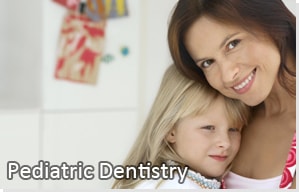

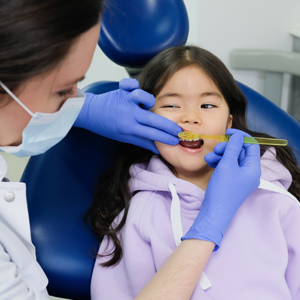 Post-Op Instructions
Post-Op Instructions
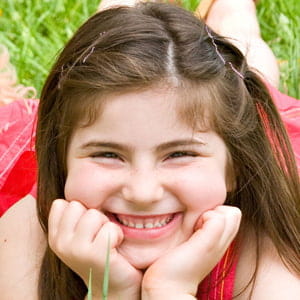 Prevention
Prevention
 Restoration
Restoration
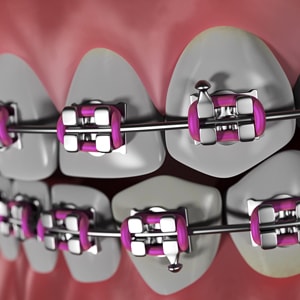 Orthodontics
Orthodontics
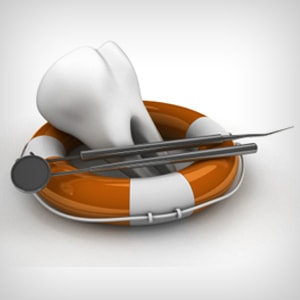 Our Services
Our Services
